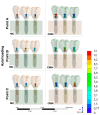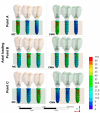Influence of Abutment Design on Biomechanical Behavior to Support a Screw-Retained 3-Unit Fixed Partial Denture
- PMID: 36143553
- PMCID: PMC9504379
- DOI: 10.3390/ma15186235
Influence of Abutment Design on Biomechanical Behavior to Support a Screw-Retained 3-Unit Fixed Partial Denture
Abstract
This study aimed to evaluate the biomechanical behavior of Morse taper implants using different abutments (CMN abutment [(CMN Group] and miniconical abutments [MC Group]), indicated to support a screw-retained 3-unit fixed partial denture. For the in vitro test, polyurethane blocks were fabricated for both groups (n = 10) and received three implants in the "offset" configuration and their respective abutments (CMN or MC) with a 3-unit fixed partial denture. Four strain gauges were bonded to the surface of each block. For the finite element analysis, 3D models of both groups were created and exported to the analysis software to perform static structural analysis. All structures were considered homogeneous, isotropic, and elastic. The contacts were considered non-linear with a friction coefficient of 0.3 between metallic structures and considered bonded between the implant and substrate. An axial load of 300 N was applied in three points (A, B, and C) for both methods. The microstrain and the maximum principal stress were considered as analysis criteria. The obtained data were submitted to the Mann-Whitney, Kruskal-Wallis, and Dunn's multiple comparison test (α = 5%). The results obtained by strain gauge showed no statistical difference (p = 0.879) between the CMN (645.3 ± 309.2 με) and MC (639.3 ± 278.8 με) and allowed the validation of computational models with a difference of 6.3% and 6.4% for the microstrains in the CMN and MC groups, respectively. Similarly, the results presented by the computational models showed no statistical difference (p = 0.932) for the CMN (605.1 ± 358.6 με) and MC (598.7 ± 357.9 με) groups. The study concluded that under favorable conditions the use of CMN or MP abutments to support a fixed partial denture can be indicated.
Keywords: biomechanics; dental implants; finite element analysis; strain gauge.
Conflict of interest statement
The authors declare no conflict of interest.
Figures











Similar articles
-
Straight and offset implant placement under axial and nonaxial loads in implant-supported prostheses: strain gauge analysis.J Prosthodont. 2012 Oct;21(7):535-9. doi: 10.1111/j.1532-849X.2012.00871.x. Epub 2012 Aug 20. J Prosthodont. 2012. PMID: 22905920
-
Microstrain around dental implants supporting fixed partial prostheses under axial and non-axial loading conditions, in vitro strain gauge analysis.J Craniofac Surg. 2013 Nov;24(6):e546-51. doi: 10.1097/SCS.0b013e31829ac83d. J Craniofac Surg. 2013. PMID: 24220463
-
Biomechanical evaluation of 3-unit fixed partial dentures on monotype and two-piece zirconia dental implants.Comput Methods Biomech Biomed Engin. 2022 Feb;25(3):239-246. doi: 10.1080/10255842.2021.1946798. Epub 2021 Sep 24. Comput Methods Biomech Biomed Engin. 2022. PMID: 34559574
-
Axial loads on implant-supported partial fixed prostheses for external and internal hex connections and machined and plastic copings: strain gauge analysis.J Oral Implantol. 2015 Apr;41(2):149-54. doi: 10.1563/AAID-JOI-D-10-00174. Epub 2013 Apr 10. J Oral Implantol. 2015. PMID: 23574373
-
Machined and plastic copings in three-element prostheses with different types of implant-abutment joints: a strain gauge comparative analysis.J Appl Oral Sci. 2010 May-Jun;18(3):225-30. doi: 10.1590/s1678-77572010000300005. J Appl Oral Sci. 2010. PMID: 20856998 Free PMC article.
Cited by
-
Biomechanical Fatigue Behavior of a Dental Implant Due to Chewing Forces: A Finite Element Analysis.Materials (Basel). 2024 Apr 5;17(7):1669. doi: 10.3390/ma17071669. Materials (Basel). 2024. PMID: 38612181 Free PMC article.
-
Failed Dental Implant: When Titanium Fractures.Diagnostics (Basel). 2023 Jun 20;13(12):2123. doi: 10.3390/diagnostics13122123. Diagnostics (Basel). 2023. PMID: 37371017 Free PMC article.
References
-
- Pjetursson B.E., Zarauz C., Strasding M., Sailer I., Zwahlen M., Zembic A. A systematic review of the influence of the implant-abutment connection on the clinical outcomes of ceramic and metal implant abutments supporting fixed implant reconstructions. Clin. Oral Implant. Res. 2018;18:160–183. doi: 10.1111/clr.13362. - DOI - PubMed
-
- Toniollo M.B., Vieira L.J.P., Dos Santos Sá M., Macedo A.P., Melo J.P., Jr., Terada A.S.S.D. Stress distribution of three-unit fixed partial prostheses (conventional and pontic) supported by three or two implants: 3D finite element analysis of ductile materials. Comput. Methods Biomech. Biomed. Eng. 2019;22:706–712. doi: 10.1080/10255842.2019.1588254. - DOI - PubMed
Grants and funding
LinkOut - more resources
Full Text Sources

